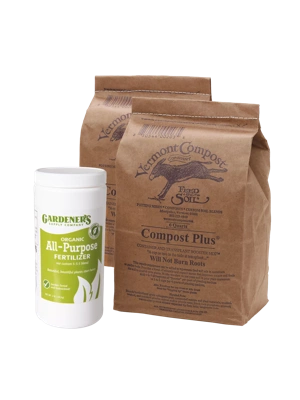Give Old Potting Soil New Life
Give your potting soil a little TLC

Provided it's disease-free, freshen up this potting soil and reuse it in raised beds, planters, and other container gardens.
First, can I reuse potting soil?
Like many aspects of gardening — it depends.
If the potting soil has just been used one season and all the plants were completely healthy, sure. However, if you know your plants ended up hit with downy mildew, or other plant disease, you'll want to either toss the soil or spend some time sterilizing it. Many fungi and viruses CAN overwinter in soil, making them especially hard to eradicate from year to year.
Sterilizing Potting Soil
Just a reminder — killing off the "bad" viruses will also kill off the "good" bacteria and microorganisms that are vital for soil and plant health. Soil sterilization can be done in the microwave or even in the oven, although this can make for an indoor mess.
Or favorite method? Using the sun, called solarization. Solarization leaves no chemical residue, is safe for organic crops, and is easy enough for home gardeners to complete.
- Remove all the contaminated stems, leaves, and roots from your potting soil. Place the contaminated potting soil in a black plastic trash bag.
- If your potting soil is completely dry, add a little bit of water; just enough to moisten the soil thoroughly.
- Seal the bag and place it in sunniest, brightest spot in your yard.
- Solarization is both time and temperature dependent — depending on your gardening climate, your soil may be sterilized anywhere in between 4 and 12 weeks. Most weed seeds are killed off at lower temperetures, however more heat is needed for plant diseases. Soil solarization is effective against fungal pathogens such as wilt, Fusarium, and Phytophthora root rot, and bacterial pathogens such potato scab.
How to Reuse Potting Soil
Ok, you've determined your old potting soil is disease-free. Now with a little TLC, you can repurpose that potting soil for another batch of beautiful hanging baskets, perfect patio planters, or ravishing raised beds.
1. Top It Off
If the level of soil in your raised bed has dropped and you plan to garden in the same space, mix in some additional fresh potting mix to regain depth again. Ideally, the soil comes to within an inch or so of the rim of the planter or raised bed. Use a fork or hand tool to blend the new soil into the old soil.

Blend new soil into the old soil.

Gardener's Supply Organic All-Purpose Fertilizer and Container Booster Mix
2. Recharge Soil Nutrients
Potting soil WILL get depeleted of nurtients over time — it's important to put in to your soil what you expect to get out of your garden beds. Compost and an organic fertilizer will bring much-needed minerals and organic matter to your potting soil:
- A granular, organic fertilizer, like Gardener's Supply Organic Fertilizer, will slowly release nitrogen, potassium, and phosphorus into the soil over time. Use 1/4 cup per square foot.
- No compost readily available at home? No problem. Try a compost-based amendment like Vermont Compost Container Booster Compost Mix. Use 3 cups per square foot. This is the secret sauce! This potent, all-organic formula includes concentrated plant and manure compost, washed granite, black rock phosphate, and other natural ingredients.

Sprinkle fertilizer and either compost, or a compost-based amendment, on to the surface of your old potting soil. Then blend with a trowel or cultivator.
Now plant! Direct seed, or transplant flowers, herbs, or your favorite edibles. Not getting the results you had hoped for? Consider testing your soil for nutrient deficiencies or pH shifts with an easy-to-use soil test kit.

Recharging older potting soil with compost and granular fertilizer set future seedlings up for success.
Last updated: 09/14/2023
Print this Article:
Related items
Get the Dirt
Stay up to date on new articles and advice. Please fill out the information below.









